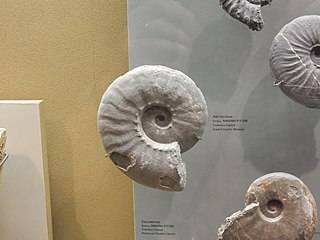Xiphogymnites is an extinct ammonoid cephalopod genus from the Triassic included in the family Gymnitidae. It is known from the Balkans in eastern Europe.
Xenodrepanites is an extinct ammonoid cephalopod genus belonging to the Ceratitida from the Upper Triassic of the Himalayas. Xenodrepanites has a very compressed, discoidal shell with a ventral furrow bordered by crenulated keels and a sub-ammonitic suture.
Xenoceltites is an extinct genus of ceratite ammonoid found worldwide in the Lower Triassic.

Arctoceras is a genus of ceratitid ammonoids from the Lower Triassic with a moderately narrow discoidal shell and ceratitic suture.
Dobrogeites is a genus of ammonoids from the order Ceratitida, included in the family Megaphyllitidae that produced evolute compressed planispiral shells with rounded venters, inner whorls ornamented as in Tirolites, outer whorls smooth, suture with multiple smooth lobes; Initially found in Anisian sediments in Romania.
Biltnerites is a genus of ammonites (s.l.) from the lower Triassic included in the ceratitacean family Tirolitidae of the order Ceratitida, characterized by a flat, evolute shell with moderately compressed, rounded whorls. The spinose stage characteristic of the Tirolitidae is absent, but the outer whorl does have indistinct ribs that cross the venter.
Beyrichites is an extinct genus in the ammonoids cephalopod, order Ceratitida from the Lower and Middle Triassic of southern Europe, Asia, and western North America.
Ussuria is a genus of Lower Triassic ammonites with a smooth, involute discoidal shell with submonophyllic sutures, belonging to the ceratitid family Ussuriidae.

Ammonitina comprises a diverse suborder of ammonite cephalopods that lived during the Jurassic and Cretaceous periods of the Mesozoic Era. They are excellent index fossils, and it is often possible to link the rock layer in which they are found to specific geological time periods.
Velebites is a genus of middle Triassic ammonites from the Balkans belonging to the Aplococeratidae, a family within the Ceratitida. It is somewhat similar to Aplococeras in external form. The shell is evolute, discoidal with convex converging whorl sides and rounded venter. Ribs are more recurved than in Aplococeras and the suture is ceratitic rather than goniatitic.

Prolecanitida is an order of extinct ammonoid cephalopods, the major Late Paleozoic group of ammonoids alongside the order Goniatitida. Prolecanitids had narrow shells, discoidal (disc-shaped) to thinly lenticular (lens-shaped). They retained a retrochoanitic siphuncle, a simple form with septal necks extending backwards. As is typical for ammonoids, the siphuncle sits along the ventral margin of the shell.

Prolecanitoidea is a taxonomic superfamily of ammonoids in the order Prolecanitida. Prolecanitoidea is one of two superfamilies in the order, along with the younger and more complex Medlicottioidea. The Prolecanitoidea were a low-diversity and morphologically conservative group. They lived from the Lower Carboniferous up to the Middle Permian. Their shells are generally smooth and discoidal, with a rounded lower edge, a moderate to large umbilicus, and goniatitic to ceratitic sutures. Suture complexity varies from 10 up to 22 total lobes ; new lobes are added from subdivision of saddles adjacent to the original main umbilical lobe.
Clydonitoidea, formerly Clydonitaceae, is a superfamily in the ammonoid cephalopod order Ceratitida characterized by generally costate and tuberculate shells with smooth, grooved, or keeled venters and sutures that are commonly ceratitic or ammonitic but goniatitic in a few offshoots.
Ceratitoidea, formerly Ceratitaceae, is an ammonite superfamily in order Ceratitida characterized in general by highly ornamented or tuberculate shells with ceratitic sutures that may become goniatitic or ammonitic in some offshoots.

Juraphyllitidae is a family of Lower Triassic phylloceratin ammonites from Europe, North Africa, and Asia characterized by narrow, evolutely coiled shells, usually with coarse ventral ribbing on the body chamber. The first lateral saddles in the suture are diphyllic, with two terminal branches, others exposed sutural saddles are diphyllic or triphyllic, those covered by successive whorls being monophyllic. A few genera are more involute, with successive whorls partially embracing the flanks of the previous. All are compressed and a few lack ribbing.
The Tropitidae is a family of Upper Triassic Ammonoidea belonging to the Tropitoidea, a superfamily of the Ceratitida
Ptychitoidea, formerly Ptychitacheae, is a superfamily of typically involute, subglobular to discoidal Ceratitida in which the shell is smooth with lateral folds or striations, inner whorls are globose, and the suture is commonly ammonitic. Their range is Middle_ and Upper Triassic.
Pinacoceratoidea, formerly Pinacocerataceae, are generally smooth, compressed, evolute to involute ammonoids from the Triassic, belonging to the Ceratitida, in which the suture is ammonitic, with adventitious and auxiliary elements.
Sirenites is a genus of ammonoid cephalopods from the Upper Triassic included in the Ceratitida, and type for the trachyceratid subfamily Sirenitinae.
Sturia is a genus of ceratitid ammonoids from the Lower Triassic with an ammonitic suture.





